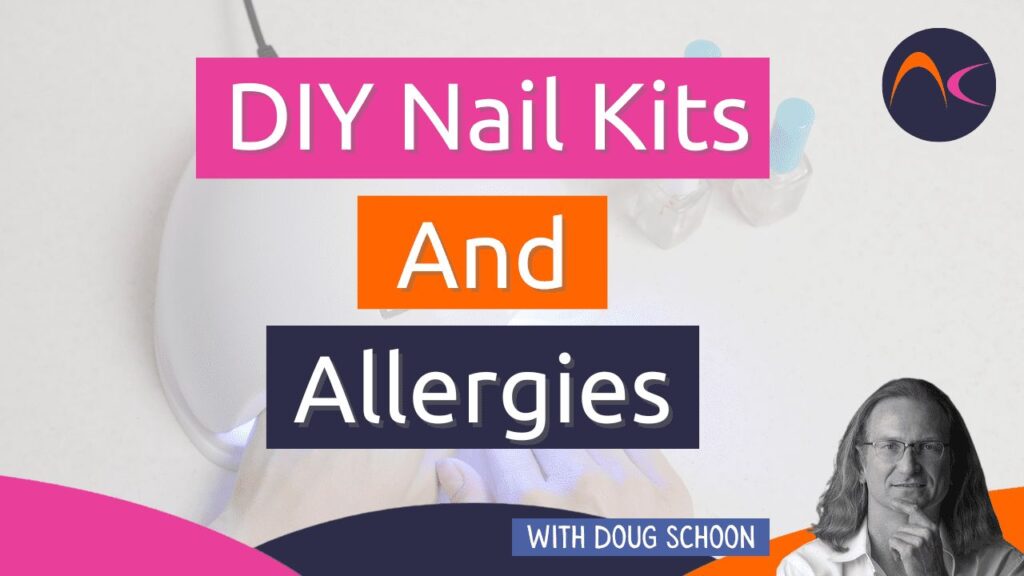There is a general concern about the DIY nail kits on the market, claiming that home gel polish kits are an overexposure reaction waiting to happen. Some even say that this is the reason for the upswing in people’s allergic reactions to enhancement products.
They could be right. The salon industry could also be tainted by negative PR related to improper home use of such products. Personally, I agree that untrained non-professionals should not use professional nail products. I also agree that DIY nail kits can lead to adverse skin reactions if people do not use them correctly and avoid skin contact.
Some clients are more likely to develop adverse skin reactions than others. Therefore, it is always best to assume that any client may develop skin sensitivity. Therefore, skin contact should always be avoided. Also, once should always properly cure nail coatings, which further reduces the potential for skin reactions. When properly cured, nail enhancements are not likely to cause adverse skin reactions of any type. Too many clients do develop skin sensitivities because nail professionals do not take care to avoid skin contact and many do not properly cure the coatings. How many clients develop skin reactions? No one can say for certain.
Adverse skin reactions are an important issue that I will be talking about a lot. However, most, if not all, of these adverse skin reactions are completely avoidable. In other words, the reactions reported are almost always due to incorrect application and/or improper cure. For instance, some adverse hair bleach reactions result from improper mixing of two-part hair bleaches or incorrect application. This is usually the result of not following the manufacturer’s directions or not heeding warnings.
I’ve served as an expert witness in many court cases over the last twenty-five years. Several cases I’ve seen have involved scalp burns. Scalp burns can happen for other reasons as well. Several happen because a stylist accidentally mixed two parts of the powdered bleach with one part of the liquid activator. That is instead of following the directions which call for one part powder bleach and two parts liquid activator. In other words, they switched the concentrations and used twice as much powdered bleach as they should have used. This type of mixing error may cause some hair bleaches to heat to over 150F (65C), which can foam and leak from the foils to burn the thin tissue on the scalp.
Many nail professionals appear to be just as likely to overexpose the skin as are the do-it-yourself crowd. I’ve watched nail professionals work for many years and I’ve seen some pay virtually no attention to avoiding skin contact. The skin around their client’s nails is red and inflamed. This type of visible irritation is very likely an early warning sign of a skin problem in development, or maybe a permanent allergic skin reaction. Permanent allergic skin reactions aren’t what they sound like, but it’s not a good thing either. Rashes and signs of visible irritation often appear to “go away” after the exposure is discontinued. However, if exposure to the allergy-causing substance resumes, the symptoms may worsen and return.
During my long career, only once do I recall a similar situation in which a retail nail coating product cause a significant increase in adverse skin reactions. This occurred when one of the first UV gel companies in the US began selling their products directly to consumers via a multi-level marketing scheme. Consumers were selling UV gel kits directly to other consumers and with virtually no training. These kits were even being sold at local fairs and street markets. The product’s application instructions were very poor and there were virtually no warnings or precautions on the packaging. Users received far too little information and no warning to avoid skin contact. To make matters worse, the UV lamp was very poorly designed. My testing showed that the nail lamp significantly under-cured the product on the nail. Here is why that matters:
Nail products harden when they exceed 50% cure, but they should be cured to about 90%. I measured the degree of cure for this retail product and believe it was about a 60% cure. It then slowly cured over the next 16 weeks, but barely achieved 70% cure. This means that the users were exposing themselves to improperly cured dust/filings, which can be a source of some skin reactions when long-term, repeated skin exposure occurs. Within six months after the commercial release of this product, users began to develop skin itching, redness, and other complaints. After a little more than a year, this nail company went out of business, which was not a surprise, given the problems they were having.
Education is the key. Information is the best way to ensure proper and safe use. When they use the right information wisely, nail techs can avoid issues related to irritation or allergy. Of course, this will also depend on how well the manufacturer has written the instructions and warnings, as well as how well they have designed their UV lamp.
Hopefully, those selling DIY nail kits will learn from these mistakes and not repeat them, e.g. using an ineffective UV nail lamp to cure the coating. My biggest concern is a company developing a retail nail lamp that they improperly designed, which did not properly cure the nail coating. This could likely lead to excessive adverse skin reactions. Unfortunately, not enough understand the important role that UV nail lamps play and why ensuring proper cure of the nail coating is an important part of safe use.


